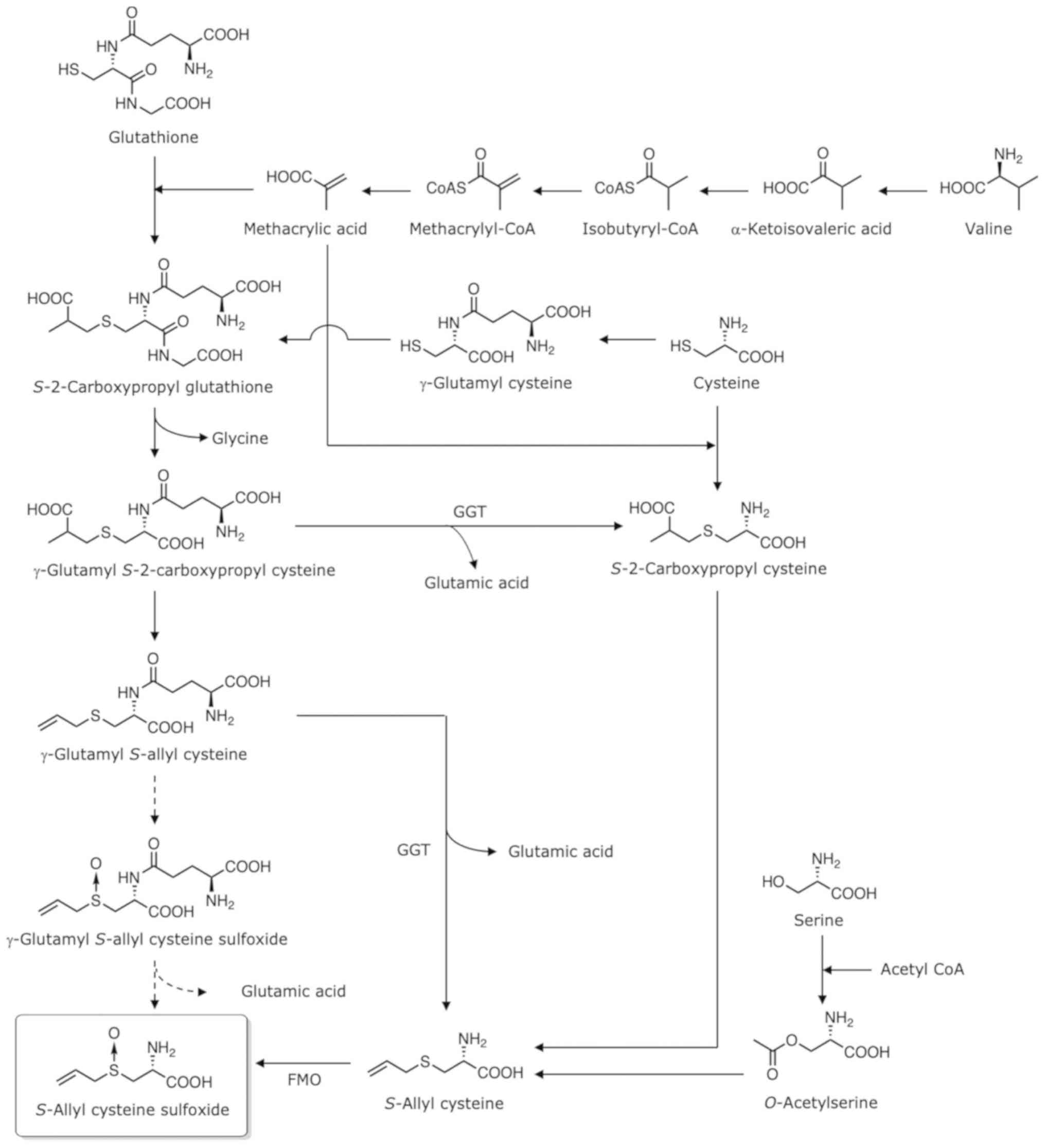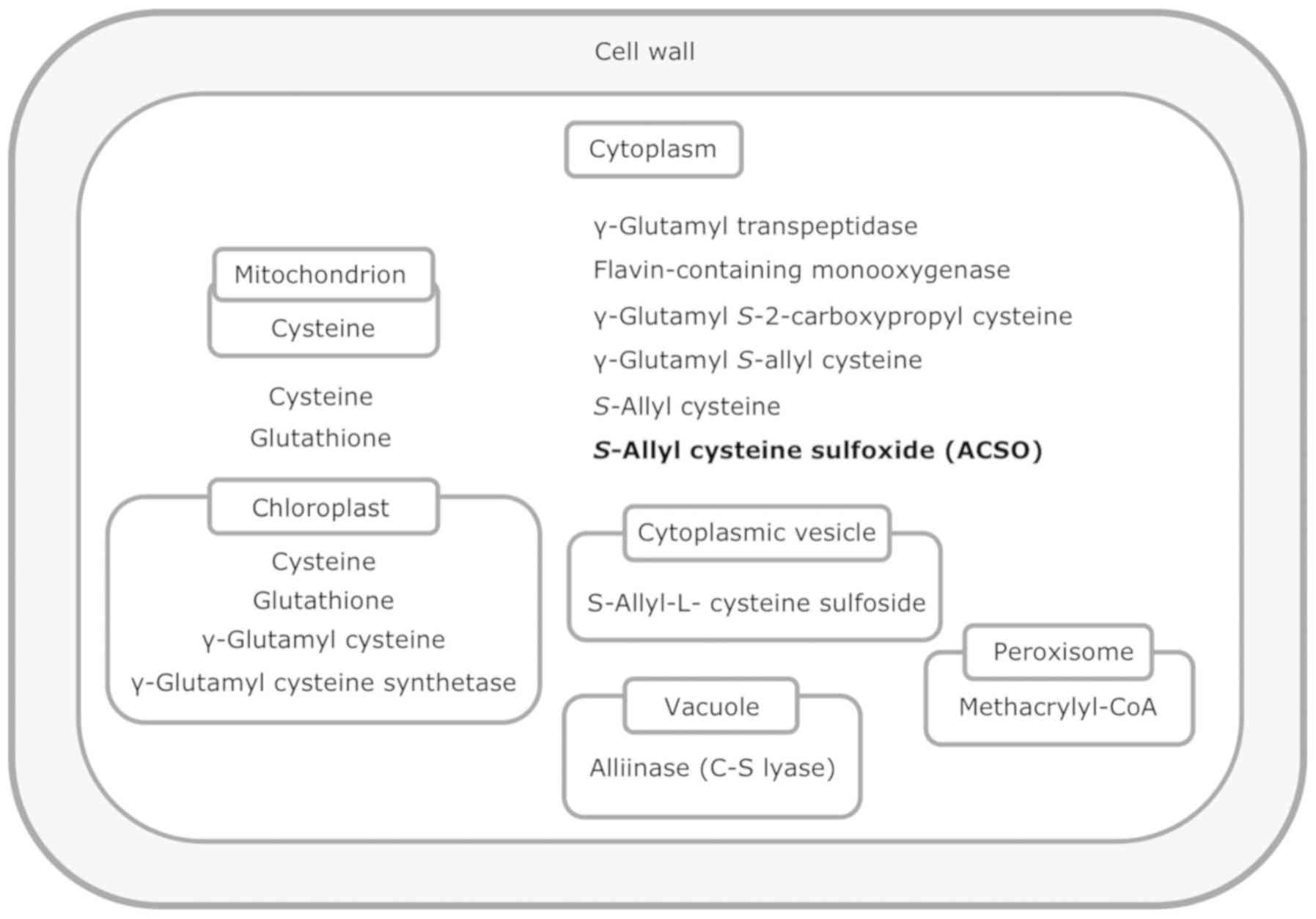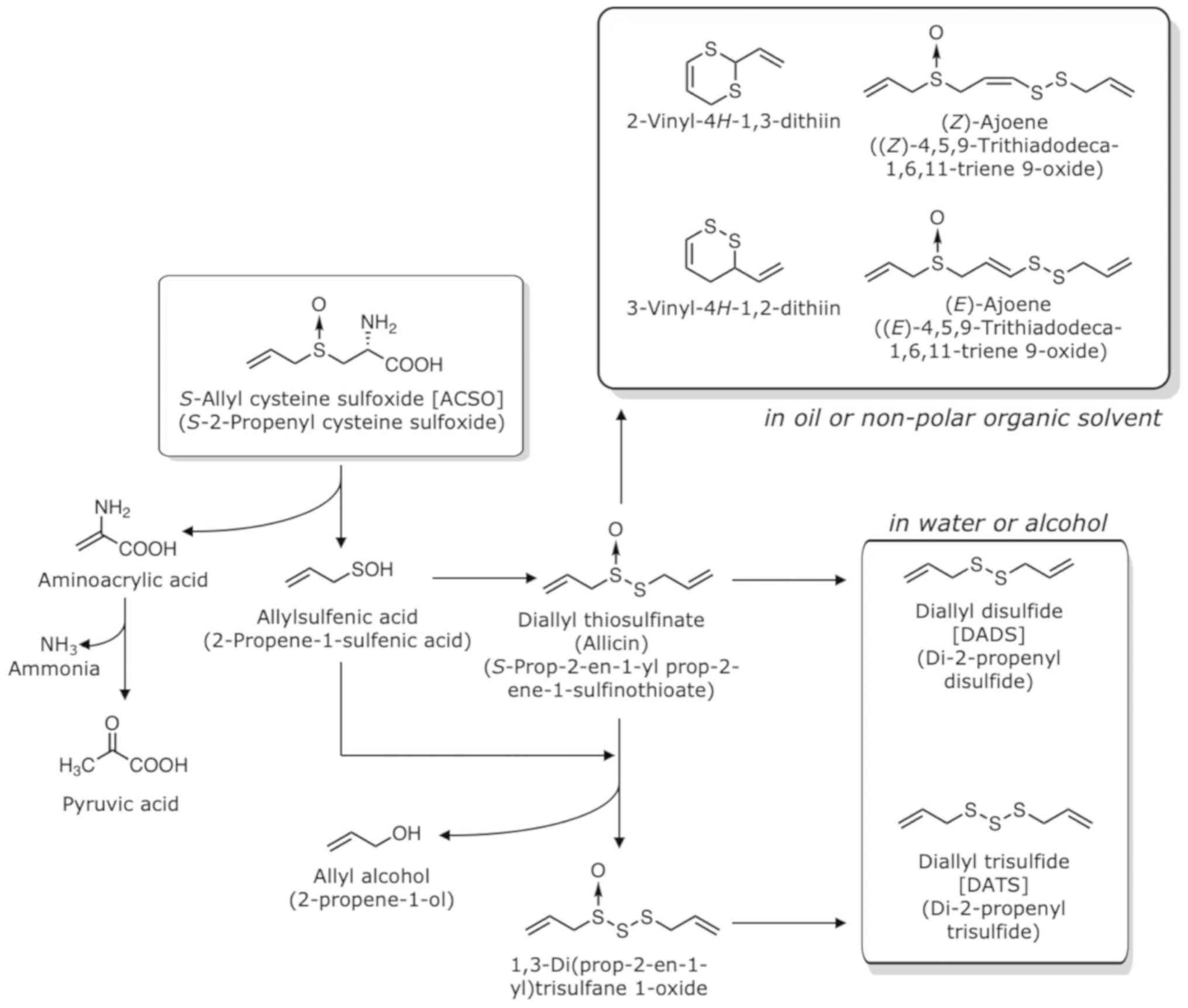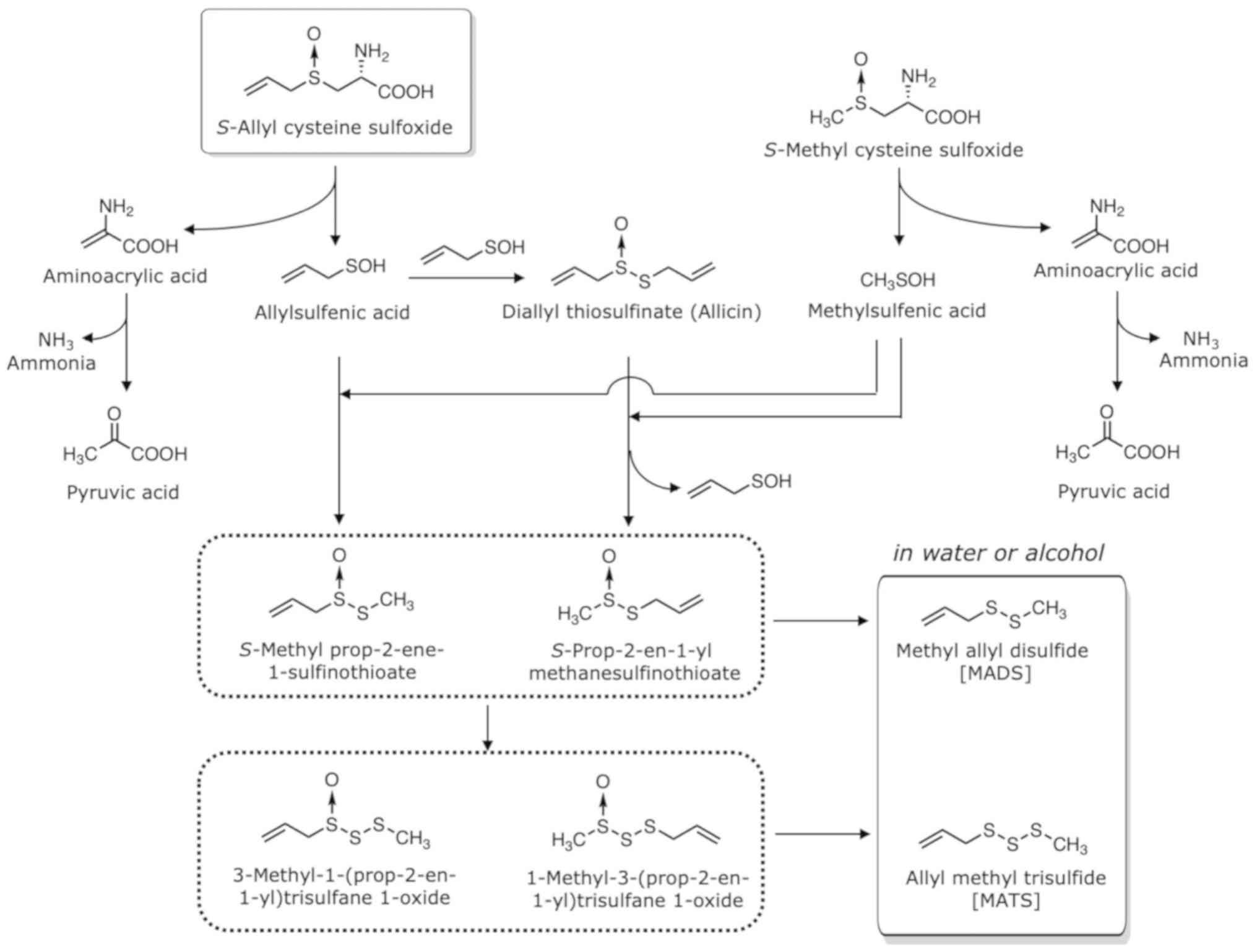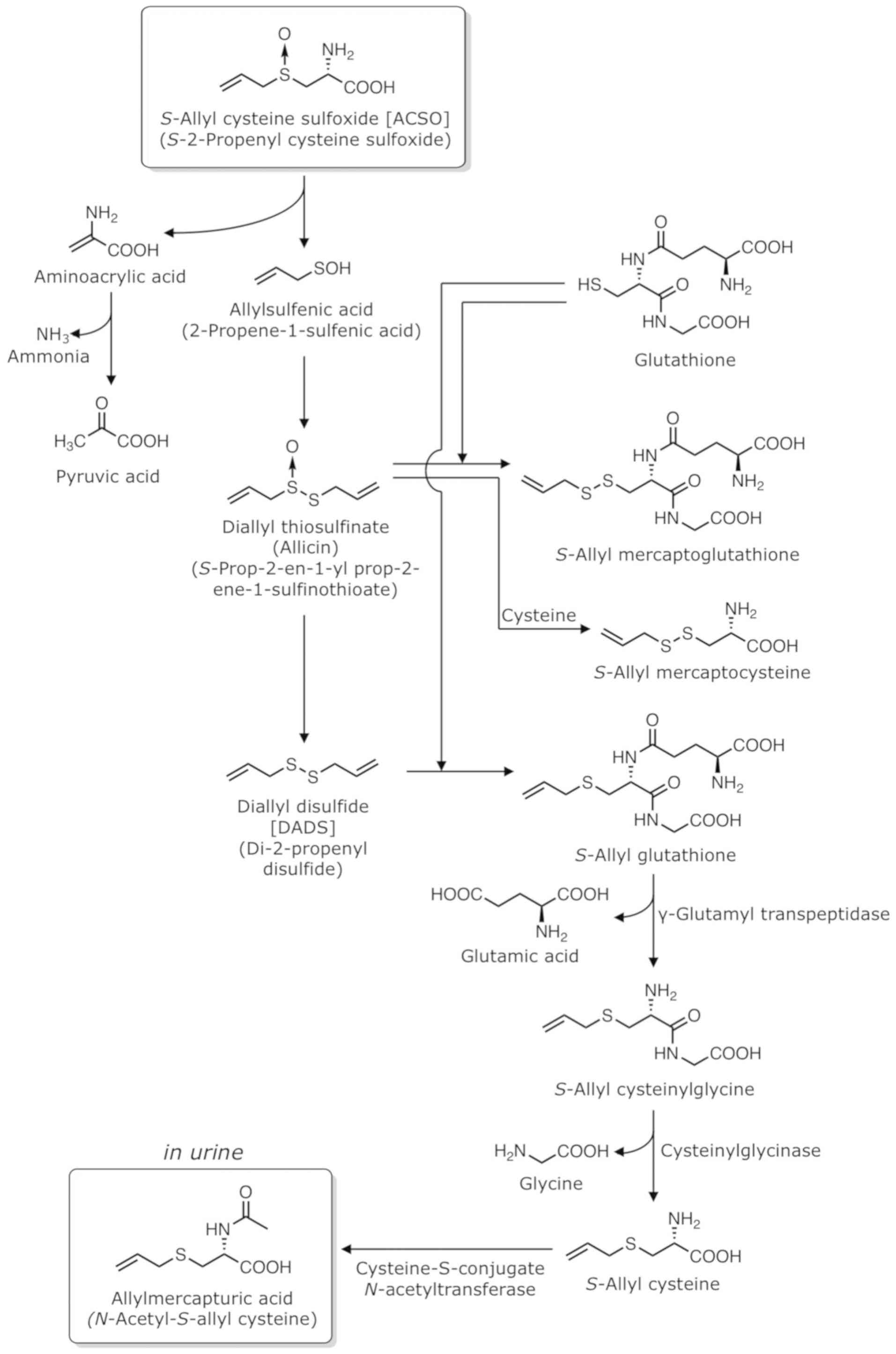|
1
|
Goncagul G and Ayaz E: Antimicrobial
effect of garlic (Allium sativum) and traditional medicine.
J Anim Vet Adv. 9:1–4. 2010. View Article : Google Scholar
|
|
2
|
Touloupakis E and Ghanotakis DF:
Nutraceutical use of garlic sulfur-containing compounds. Adv Exp
Med Biol. 698:110–121. 2010. View Article : Google Scholar : PubMed/NCBI
|
|
3
|
Rahman MS, Al-Sheibani HI, Al-Riziqi MH,
Mothershaw A, Guizani N and Bengtsson G: Assesment of the
anti-microbial activity of dried garlic powders produced by
different methods of drying. Int J Food Prop. 9:503–513. 2006.
View Article : Google Scholar
|
|
4
|
Durak I, Aytaç B, Atmaca Y, Devrim E, Avci
A, Erol C and Oral D: Effects of garlic extract consumption on
plasma and erythrocyte antioxidant parameters in atherosclerotic
patients. Life Sci. 75:1959–1966. 2004. View Article : Google Scholar : PubMed/NCBI
|
|
5
|
Padiya R, Chowdhury D, Borkar R, Srinivas
R, Pal Bhadra M and Banerjee SK: Garlic attenuates cardiac
oxidative stress via activation of PI3K/AKT/Nrf2-Keap1 pathway in
fructose-fed diabetic rat. PLoS One. 9:e942282014. View Article : Google Scholar : PubMed/NCBI
|
|
6
|
Bongiorno PB, Fratellone PM and LoGiudice
P: Potential health benefits of garlic (Allium sativum): A
narrative review. J Complement Integr Med. 5:1–26. 2008. View Article : Google Scholar
|
|
7
|
Rose P, Whiteman M, Moore PK and Zhu YZ:
Bioactive S-alk(en)yl cysteine sulfoxide metabolites in the
genus Allium: The chemistry of potential therapeutic agents.
Nat Prod Rep. 22:351–368. 2005. View
Article : Google Scholar : PubMed/NCBI
|
|
8
|
Zawistowski J, Kopec A, Jedrszczyk E,
Francik R and Bystrowska B: Garlic grown from air bulbils and its
potential health benefits. ACS Symp Ser. 1286:315–328. 2018.
View Article : Google Scholar
|
|
9
|
Mithen R: Sulphur-containing compounds.
Plant secondary metabolites: occurrence, structure and role in the
human diet. Crozier A, Clifford N and Ashida H: Blackwell
Publishing; Hoboken, NJ: pp. 25–46. 2006, View Article : Google Scholar
|
|
10
|
Palani S, Joseph NM, Tegene Y and Zacharia
A: Medical properties of garlic - A concise review. Curr Res Pharm
Sci. 4:92–98. 2014.
|
|
11
|
Ueda Y, Sakaguchi M, Hirayama K, Miyajima
R and Kimizuka A: Characteristic flavor constituents in water
extract of garlic. Agric Biol Chem. 54:163–169. 1990. View Article : Google Scholar
|
|
12
|
Granroth B: Biosynthesis and decomposition
of cysteine derivatives in onion and other Allium species.
Ann Acad Sci Fenn, Ser A2. Chem. 154:1–71. 1970.
|
|
13
|
Jones MG, Hughes J, Tregova A, Milne J,
Tomsett AB and Collin HA: Biosynthesis of the flavour precursors of
onion and garlic. J Exp Bot. 55:1903–1918. 2004. View Article : Google Scholar : PubMed/NCBI
|
|
14
|
Hughes J, Tregova A, Tomsett AB, Jones MG,
Cosstick R and Collin HA: Synthesis of the flavour precursor,
alliin, in garlic tissue cultures. Phytochemistry. 66:187–194.
2005. View Article : Google Scholar : PubMed/NCBI
|
|
15
|
Suzuki T, Sugii M and Kakimoto T:
Metabolic incorporation of L-valine-[14C] into
S-(2-carboxypropyl) glutathione and
S-(2-carboxypropyl) cysteine in garlic. Chem Pharm Bull
(Tokyo). 10:328–331. 1962. View Article : Google Scholar : PubMed/NCBI
|
|
16
|
Lancaster JE and Shaw ML: γ-Glutamyl
peptides in the biosynthesis of S-alk(en)yl-L-cysteine
sulfoxides (flavor precursors) in Allium. Phytochemistry.
28:455–460. 1989. View Article : Google Scholar
|
|
17
|
Yoshimoto N, Onuma M, Mizuno S, Sugino Y,
Nakabayashi R, Imai S, Tsuneyoshi T, Sumi S and Saito K:
Identification of a flavin-containing S-oxygenating
monooxygenase involved in alliin biosynthesis in garlic. Plant J.
83:941–951. 2015. View Article : Google Scholar : PubMed/NCBI
|
|
18
|
Yoshimoto N, Yabe A, Sugino Y, Murakami S,
Sai-Ngam N, Sumi S, Tsuneyoshi T and Saito K: Garlic γ-glutamyl
transpeptidases that catalyze deglutamylation of biosynthetic
intermediate of alliin. Front Plant Sci. 5:7582015. View Article : Google Scholar : PubMed/NCBI
|
|
19
|
Suzuki T, Sugii M, Kakimoto T and Tsuboi
N: Isolation of (−)-S-allyl-L-cysteine from garlic. Chem
Pharm Bull (Tokyo). 9:251–252. 1961. View Article : Google Scholar
|
|
20
|
Ziegler SJ and Sticher O: HPLC of
S-alk(en)yl-L-cysteine derivatives in garlic including
quantitative determination of (+)-S-allyl-L-cysteine
sulfoxide (alliin). Planta Med. 55:372–378. 1989. View Article : Google Scholar : PubMed/NCBI
|
|
21
|
Lawson LD, Wang Z-Y and Hughes BG:
γ-Glutamyl-S-alkylcysteines in garlic and other Allium spp.:
Precursors of age-dependent trans−1-propenyl thiosulfinates.
J Nat Prod. 54:436–444. 1991. View Article : Google Scholar
|
|
22
|
Farooqui AA and Farooqui T: Garlic and its
effects in neurological disorders. Neuroprotective effects of
phytochemicals in neurological disorders. John Wiley & Sons;
Hoboken, NJ: pp. 113–131. 2017, View Article : Google Scholar
|
|
23
|
Hirata S, Abdelrahman M, Yamauchi N and
Shigyo M: Characteristics of chemical components in genetic
resources of garlic Allium sativum collected from all over
the world. Genet Resour Crop Evol. 63:35–45. 2016. View Article : Google Scholar
|
|
24
|
Lawson LD: Garlic: A review of its
medicinal effects and indicated active compounds. ACS Symp Ser.
691:176–209. 1998. View Article : Google Scholar
|
|
25
|
Ueda Y, Kawajiri H, Miyamura N and
Miyajima R: Content of some sulfur-containing components and free
amino acids in various strains of garlic. Nippon Shokuhin Kogyo
Gakkaishi (J Jpn Soc Food Sci Technol). 38:429–434. 1991.
View Article : Google Scholar
|
|
26
|
Mütsch-Eckner M, Sticher O and Meier B:
Reversed-phase high-performance liquid chromatography of
S-alk(en)yl-L-cysteine derivatives in Allium sativum
including the determination of (+)-S-allyl-L-cysteine
sulphoxide, γ-L-glutamyl-S-allyl-L-cysteine and
γ-L-glutamyl-S-(trans−1-propenyl)-L-cysteine. J
Chromatogr A. 625:183–190. 1992. View Article : Google Scholar
|
|
27
|
Bloem E, Haneklaus S and Schnug E: Storage
life of field-grown garlic bulbs (Allium sativum L.) as
influenced by nitrogen and sulfur fertilization. J Agric Food Chem.
59:4442–4447. 2011. View Article : Google Scholar : PubMed/NCBI
|
|
28
|
Yamazaki Y and Okuno T: Accumulation of
S-allyl-L-cysteine in garlic bulbs by warming. Nippon
Shokuhin Kagaku Kogaku Kaishi. 55:410–415. 2008. View Article : Google Scholar
|
|
29
|
Rahman MS: Allicin and other functional
active components in garlic: Health benefits and bioavailability.
Int J Food Prop. 10:245–268. 2007. View Article : Google Scholar
|
|
30
|
Martins N, Petropoulos S and Ferreira
ICFR: Chemical composition and bioactive compounds of garlic
(Allium sativum L.) as affected by pre- and post-harvest
conditions: A review. Food Chem. 211:41–50. 2016. View Article : Google Scholar : PubMed/NCBI
|
|
31
|
Matsuura H, Inagaki M, Maeshige K, Ide N,
Kajimura Y and Itakura Y: Changes in contents of γ-glutamyl
peptides and fructan during growth of Allium sativum. Planta
Med. 62:70–71. 1996. View Article : Google Scholar : PubMed/NCBI
|
|
32
|
Ellmore GS and Feldberg RS: Allin lyase
localization in bundle sheaths of the garlic clove (Allium
sativum). Am J Bot. 81:89–94. 1994. View Article : Google Scholar
|
|
33
|
Penn RE, Block E and Revelle LK: Flash
vacuum pyrolysis studies. 5. Methanesulfenic acid. J Am Chem Soc.
100:3622–3623. 1978. View Article : Google Scholar
|
|
34
|
Cavallito CJ, Buck JS and Suter CM:
Allicin, the antibacterial principle of Allium sativum. II.
Determination of the chemical structure. J Am Chem Soc.
66:1952–1954. 1944. View Article : Google Scholar
|
|
35
|
Borlinghaus J, Albrecht F, Gruhlke MC,
Nwachukwu ID and Slusarenko AJ: Allicin: Chemistry and biological
properties. Molecules. 19:12591–12618. 2014. View Article : Google Scholar : PubMed/NCBI
|
|
36
|
Choi MK: CHae K-Y, Lee J-Y and Kyung KH:
Antimicrobial activity of chemical substances derived from
S-alk(en)yl-L-cysteine sulfoxide (alliin) in garlic,
Allium sativum L. Food Sci Biotechnol. 16:1–7. 2007.
|
|
37
|
Rabinkov A, Miron T, Konstantinovski L,
Wilchek M, Mirelman D and Weiner L: The mode of action of allicin:
Trapping of radicals and interaction with thiol containing
proteins. Biochim Biophys Acta. 1379:233–244. 1998. View Article : Google Scholar : PubMed/NCBI
|
|
38
|
Lawson LD, Wang ZJ and Hughes BG:
Identification and HPLC quantitation of the sulfides and
dialk(en)yl thiosulfinates in commercial garlic products. Planta
Med. 57:363–370. 1991. View Article : Google Scholar : PubMed/NCBI
|
|
39
|
Singh VK and Singh DK: Pharmacological
effects of garlic (Allium sativum L.). Ann Rev Biomed Sci.
10:6–26. 2008.
|
|
40
|
Block E, Naganathan S, Putman D and Zhao
SH: Allium chemistry: HPLC analysis of thiosulfinates from
onion, garlic, wild garlic (ramsoms), leek, scallion, shallot,
elephant (great-headed) garlic, chive, and Chinese chive. Uniquely
high allyl to methyl ratios in some garlic samples. J Agric Food
Chem. 40:2418–2430. 1992. View Article : Google Scholar
|
|
41
|
Yamaguchi Y, Honma R, Yazaki T, Shibuya T,
Sakaguchi T, Uto-Kondo H and Kumagai H: Sulfuric odor precursor
S-allyl-L-cysteine sulfoxide in garlic induces detoxifying
enzymes and prevents hepatic injury. Antioxidants. 8:3852019.
View Article : Google Scholar
|
|
42
|
Bartzatt R, Blum D and Nagel D: Isolation
of Garlic Derived Sulfur Compounds from Urine. Anal Lett.
25:1217–1224. 1992. View Article : Google Scholar
|
|
43
|
de Rooij BM, Boogaard PJ, Rijksen DA,
Commandeur JN and Vermeulen NP: Urinary excretion of
N-acetyl-S-allyl-L-cysteine upon garlic consumption
by human volunteers. Arch Toxicol. 70:635–639. 1996. View Article : Google Scholar : PubMed/NCBI
|
|
44
|
Jandke J and Spiteller G: Unusual
conjugates in biological profiles originating from consumption of
onions and garlic. J Chromatogr A. 421:1–8. 1987. View Article : Google Scholar
|
|
45
|
Trio PZ, You S, He X, He J, Sakao K and
Hou D-X: Chemopreventive functions and molecular mechanisms of
garlic organosulfur compounds. Food Funct. 5:833–844. 2014.
View Article : Google Scholar : PubMed/NCBI
|
|
46
|
Verhagen H, Hageman GJ, Rauma A-L,
Versluis-de Haan G, van Herwijnen MHM, de Groot J, Törrönen R and
Mykkänen H: Biomonitoring the intake of garlic via urinary
excretion of allyl mercapturic acid. Br J Nutr. 86 (Suppl
1):S111–S114. 2001. View Article : Google Scholar : PubMed/NCBI
|
|
47
|
Augusti KT and Sheela CG: Antiperoxide
effect of S-allyl cysteine sulfoxide, an insulin
secretagogue, in diabetic rats. Experientia. 52:115–120. 1996.
View Article : Google Scholar : PubMed/NCBI
|
|
48
|
Zhai B, Zhang C, Sheng Y, Zhao C, He X, Xu
W, Huang K and Luo Y: Hypoglycemic and hypolipidemic effect of
S-allyl-cysteine sulfoxide (alliin) in DIO mice. Sci Rep.
8:35272018. View Article : Google Scholar : PubMed/NCBI
|
|
49
|
Sangeetha T and Darlin Quine S: Preventive
effect of S-allyl cysteine sulphoxide (Alliin) on
mitochondrial dysfunction in normal and isoproterenol induced
cardiotoxicity in male Wistar rats: A histopathological study. Mol
Cell Biochem. 328:1–8. 2009. View Article : Google Scholar : PubMed/NCBI
|
|
50
|
Nishimura H and Ariga T: Vinyldithiins in
garlic and Japanese domestic Allium (A. victorialis).
CS Symp Ser. 546:128–143. 1993.
|
|
51
|
Akao M, Shibuya T, Shimada S, Sakurai H
and Kumagai H: In vivo production of bioactive compounds from
S-allyl-L-cysteine sulfoxide, garlic odor precursor, that
inhibit platelet aggregation. J Clin Biochem Nutr. (Suppl 43):1–3.
2008.
|
|
52
|
Uto-Kondo H, Hase A, Yamaguchi Y, Sakurai
A, Akao M, Saito T and Kumagai H: S-Allyl-L-cysteine
sulfoxide, a garlic odor precursor, suppresses elevation in blood
ethanol concentration by accelerating ethanol metabolism and
preventing ethanol absorption from gut. Biosci Biotechnol Biochem.
82:724–731. 2018. View Article : Google Scholar : PubMed/NCBI
|















